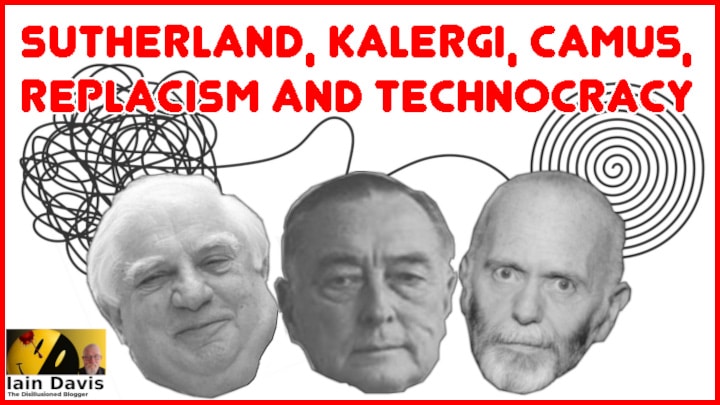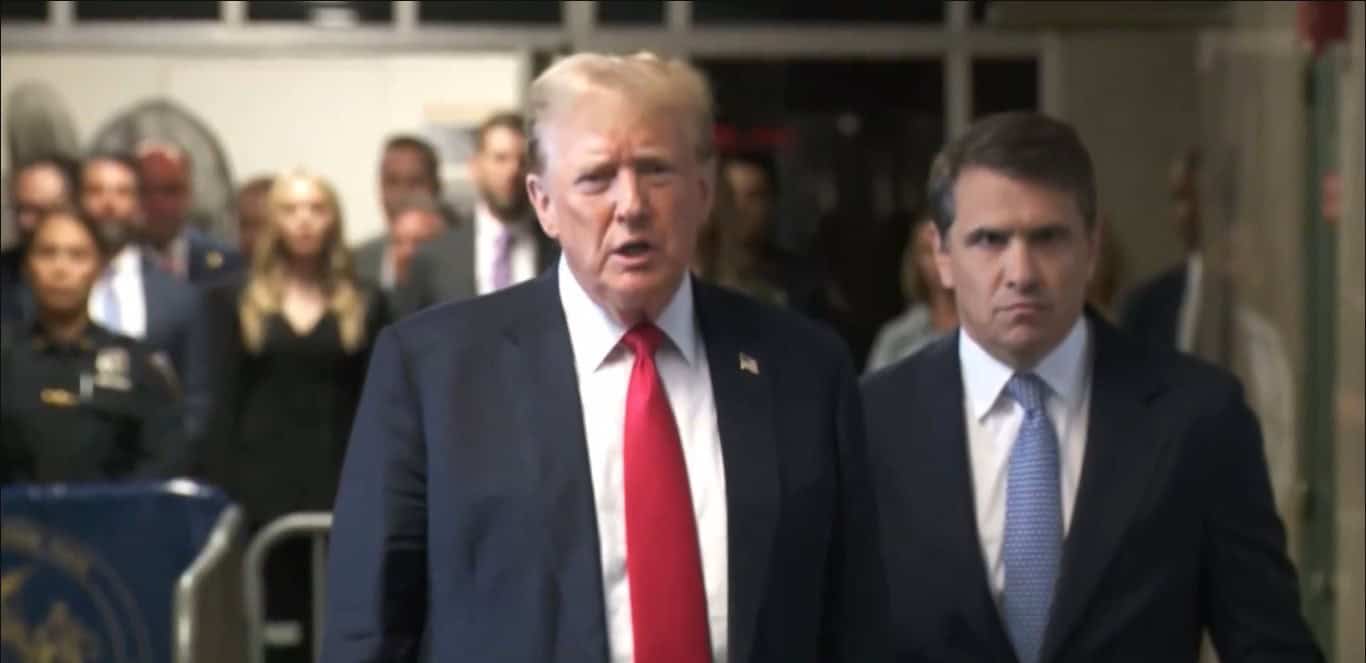

Markets Quake as Monopolist Capital Pursues a Technological Coup
A serious omission is notable in the circulating list of suspects responsible for the early August quake in global risk-on markets. This is the role of “monopoly capital” in stimulating wild technological change which by-passes potential benign control by the invisible hands of free markets.
In assessing the charge against monopoly capital, the concept of revolution and its differentiation from coup is important. Revolution starts from below amidst a groundswell of new ideas and individual actions. Its continuing progress means at some point an overturning of the status quo regime. A coup by contrast describes a change in regime brought about by deliberate plotting on the part of a group within the present elites,
The distinction is perhaps most obvious in the case of politics. Ryan McMaken reviewed recently how the “October revolution in Russia 1917” in which the Bolsheviks assumed power was a coup not a revolution. We can extend the concept to waves of technological change.
The great technological revolutions of modern times, maybe as far back as the printing press and all the way forward to digitalization say from the early 1990s to 2000s, all started from below. They included at an early-stage great participation from small-sized innovators competing at all stages from basic design to ultimately applications. Competition also remained fierce with the pre-revolution technology. An array of competitors using prior capital equipment technologies exerted a brake on headlong and wasteful adoption of new technologies still untried and underdeveloped to a considerably degree by making bold pre-emptive price-cuts so as to salvage some returns despite obsolescence.
Consider the alternative to such revolution from below – technological change as driven from “above”, albeit featuring still spontaneous innovations in some areas of application. Monopolists or oligopolists or Big Government are then in charge of the process of new technology introduction meaning this has the characteristics of a coup rather than a revolution. The process has special danger as we shall see for the present case of Artificial Intelligence (AI).
Big powerful existing technology firms who control already the gateway platforms to the internet are playing a key role both in the technical innovations (developing the language models) and then in deploying massive capital to implement them. Spending by just 5 Big Tech companies – Alphabet, Apple, Amazon, Meta and Microsoft – on AI amounted to $60bn in 2024Q2, up 65% from a year earlier.
Commentators stress the importance of FOMO (fear of missing out); present monopolists have been fearful of profits erosion by new entrants to the tech industry if they do not act first, safeguarding the “kill zones” around their existing products and services. Yes, there are many unicorns amongst the start-ups which are seeking to apply AI. But, that is much further downstream in the process of technological change and is not a threat to the tech monopolists’ profit. Indeed, the opposite is true given the likely structure of monopoly fees for access to key inputs.
Commentators and indeed even great economists have exposed themselves to the charge of obsequious acquiescence in technological change whatever its form. Some have lauded the role of monopoly power in accelerating the process. We can go all the way back to Schumpeter’s conversion to a belief (opposite to in his early writings) that temporary monopoly power is beneficial in intensifying the process of creative destruction and thereby technological change.
The obsequiousness apparent in widespread societal attitudes to those leading the technological change, even if ugly in key respects, can be explained by the perception that technological revolution is intrinsic to how capitalism builds prosperity over time. We all know those charts showing an explosion of economic growth in the past two hundred years which accompany the new phenomenon of persistent waves of technological change.
Yet all of this is not to say that bigger and more rapid revolutions are always a Good Thing. The invisible hands of the market ideally influence the pace and extent of technological change so as to maximize possible living standards over time. But this means neither driving too fast into the forest of the unknown rather than benefiting from the passage of time to learn about the downsides nor jettisoning ruthlessly earlier technologies meaning immediate obsolescence of pre-existing capital stock. There is no guarantee that on every occasion the invisible hands will succeed in that mission – but as for democracy we can say they are a better proposition than the alternatives for that purpose.
The empirical evidence in favour of non-competitive conditions spurring technological change is at best ambiguous. And we should be wary of economists asserting as a tautology that faster technological progress is always better than slower. The invisible hands should restrain as well as incentivize. The invisible hands of market forces ideally determine the pace of technological change including application in a highly decentralized way (not amongst a cabal of oligopolists) across a vast array of economic activities at an enterprise level.
Even under sound money and highly competitive markets in product and services it is possible for the invisible hands to preside over serious error in the path of technological change. Most obviously there might be a failure at the start for all to envisage snags in the technology and large ensuing costs. And the guardrails of free market capitalism might fail in the context of the new technology, allowing powerful monopolies to form and much malfeasance to occur especially as regards the trampling over pre-existing property rights (including ownership of private information).
Let’s illustrate these concerns with the IT revolution, starting broadly in the 1990s, and under at first highly competitive conditions, but almost continuously under conditions if monetary inflation. It is implausible that the full extent of virus vulnerability in much of the new software was at all apparent in the early years – or the extent of resources which would have to be deployed in defence and the possible inadequacies of this. Yet once the true extent of the costs become apparent, there is no going back.
Monetary inflation has crippled or distorted seriously the invisible hands beyond the amount due to just stark flaws of original vision. A characteristic of asset inflation is search for yield amidst speculative narratives which spread without the normal push-back from sober rationality. Especially in a very low-interest rate environment investors become entranced by the possibility of a long-run stream of monopoly rents emerging; firms which promise this as part of their speculative narrative enjoy a premium. The scope for monopoly in the IT revolution has been notorious – network effects and establishing gateway platforms. And persistent asset inflation has abetted the growth of monopoly capital. Yield-hungry investors have collectively put large premiums on the equity of enterprises with a plausible path to achieving a long-run stream of monopoly rents.
The monopoly capitalists attained new scope to plot a technology coup in recent years with the advent of AI. An eye-opener to the extent of malevolence is now evident in legal dispute between Elon Musk as co-founder and original key financier of Open AI and its chief executive Sam Altman. Musk accusing Altman of deceptively maintaining at the start that Open AI was a non-profit research institute rather than an enterprise in which a controlling partnership via a subsidiary – would subsequently be consummated with Microsoft (also in at the start with Open AI).
It is implausible that the processes of monopoly-led coups will lead to anything like the optimal rate of technological progress which could likely emerge under sound money and competitive capitalism. Extreme optimism has reigned in the marketplace about the potential monopoly profits (in this example via Chat GBT) from such “plots amongst the oligopolists” – hence all the buzz about the magnificent seven amidst a chorus including Nobel economists and Big Business titans about the productivity surge which lies ahead.
Pessimism though can suddenly break out as we saw in early August. The uninformed child can call out that the emperor is naked. Those tens of billions of capital expenditure by the monopolists on AI, where will be the return? Such doubts would multiply if monetary inflation were indeed now losing strength, perhaps because the rhythm of goods prices is no longer downwards given that supply conditions have generally normalized two to three years on from the pandemic. Monetary authorities will have to work harder (in terms of exerting monetary restraint) to achieve their two per cent inflation target than was the case during 2023-4.
Bottom line: technological change related to AI is occurring largely under the control of the monopolists who rule over the great gateway platforms and has the characteristics of coup rather than revolution. The coup has been featuring a wave of tremendous spending by Big Tech. Jitters have been evident recently in the marketplace that this has gone far beyond what can produce good returns in the future. Hence considerable financial instability and economic disappointment would lie ahead.
Originally Posted at https://mises.org/
Stay Updated with news.freeptomaineradio.com’s Daily Newsletter
Stay informed! Subscribe to our daily newsletter to receive updates on our latest blog posts directly in your inbox. Don’t let important information get buried by big tech.
Current subscribers:

A Review of Nock’sThe Theory of Education in the United States
Albert J. Nock was one of Murray Rothbard’s favorite essayists, and for good reason; his erudition, clarity of thought, and wisdom make his works supremely edifying and a joy to read, and none more so than his Theory of Education in the United States (1932).
Nock sets out to examine the theoretical underpinnings of the American education system, which that had undergone an ill-fated organizational “revolution” around the turn of the 20th century and, after three decades of continuous tinkering since, was universally viewed as decidedly deficient. Any construct, he reasons, builds upon theoretical considerations; if a system cannot be made to yield satisfactory results after so much “improvement,” then perhaps the underlying theory is unsound. Thus, he identifies three axiomatic principles of American education: equality, democracy, and, as a raison d’être for the education system, the idea that a literate citizenry ensures “good public order and honest government.”
The principle of equality holds that everyone is educable, by which is meant the existence of fertile ground such that the process of education as outlined below might bear fruit. The principle of democracy implies that the education system should “give the people what they want,” and thus that what is taught should reflect what the masses wish to learn. And the patriotic nature of the third principle implies that the education system should concern the whole citizenry and the institutions of government. As he compellingly shows, however, all three are manifestly untenable.
His argument rests on the distinction between formative and instrumental knowledge, and between education and training. While instrumental knowledge conveys a useful skill, formative knowledge has no direct applicability to daily life, but rather induces a way of thinking. Analogously, training has as its purpose the conveyance of instrumental knowledge, while education aims to produce, through the disinterested pursuit of formative knowledge, a disciplined mind capable of “right thinking, clear thinking, mature and profound thinking.” The purpose of a system of education is to identify the vanishingly small minority of educable persons in a society and allow them to attempt such a transformation. Consider Nock’s description of the system of education that had evolved since the Middle Ages:
Let us suppose that an educable person found good schools and a good college, … what would he do, and what might be expected of him? After [reading, writing, and arithmetic], his staples were Latin, Greek, and mathematics. He took up the elements of these two languages very early, and continued at them, with arithmetic and algebra, nearly all the way through the primary, and all the way through the secondary schools. Whatever else he did, if anything, was inconsiderable except as related to these major subjects…. When he reached the undergraduate college at the age of sixteen or so, all his language-difficulties with Greek and Latin were forever behind him; he could read anything in either tongue, and write in either, and he was thus prepared to deal with both literatures purely as literature, to bestow on them a purely literary interest. He had also in hand arithmetic, and algebra as far as quadratics. Then in four years at college he covered practically the whole range of Greek and Latin literature; mathematics as far as the differential calculus, and including the mathematics of elementary physics and astronomy; a brief course, covering about six weeks, in formal logic; and one as brief in the bare history off the formation and growth of the English language.
Given the complete absence of any such concentrated curriculum in the modern world, we are justified in asking why a focus on dead languages and mathematics should be any more transformative than living languages and science. Nock provides the following answer:
The literatures of Greece and Rome comprise the longest and fullest continuous record available to us, of what the human mind has been busy about in practically every department of spiritual and social activity [with the exception of music, spanning 2500 years of the human mind’s operation.] … Hence the mind that has attentively canvassed this record is not only a disciplined mind but an experienced mind; a mind that instinctively views any contemporary phenomenon from the vantage-point of an immensely long perspective attained through this profound and weighty experience of the human mind’s operations…. These studies … were regarded as formative because they are maturing, because they powerfully inculcate the views of life and the demands on life that are appropriate to maturity and that are indeed the specific marks, the outward and visible signs, of the inward and spiritual grace of maturity. And now we are in a position to observe that the establishment of these views and the direction of these demands is what is traditionally meant, and what we citizens of the republic of letters now mean, by the word education; and the constant aim at inculcation of these views and demands is what we know under the name of the Great Tradition of our republic.
Nock points out that the substitution of a universal system of training for this elitist, classical system of education came about as a predictable consequence of the broad adoption of said three principles. That they should be so popular arises, in turn, from the wish that one’s children should have it better:
First, there was this strong sentiment for one’s children, and for their progress in a civilized life. The conception of a civilized life, of its nature, and of the way to enter into it, was and is often most imperfect, but no matter; the sentiment was itself noble and disinterested. One’s children should have, at any cost or sacrifice, all the education they could get. Then, playing directly into the hand of this sentiment, there was the idea of equality prompting the belief that they were all capable of taking in and assimilating what there was to be had; and then the idea of democracy, prompting the belief that the whole subject-matter of education should be common property, not common in a true and proper sense, but, roughly, in the sense that so much of it as was not manageable by everybody should be disallowed and disregarded. Then finally, all this had the general sanction of a pseudo-patriotic idea that in thus doing one’s best for one’s children, one was also doing something significant in the way of service to one’s country.
Regardless of the noble intentions at its root, the transformation of the education system into one of broad, public training is detrimental to the long-term health of our civilization, for in all of recorded history, “no society ever yet has [neglected the cultivation of serious thinkers] without coming to great disaster.” Nock explains that educable persons are valuable, but since the current system does not allow us to capitalize on their value, they “simply go to waste.” In a passage eerily prescient of the catastrophic institutional failures so common in our day, he explains this value as follows:
At present our society is in most serious … difficulties. The truly mature person, bred in the Great Tradition, could at any time have reached into his accumulation of experience and found a match for each one of these difficulties, and for every circumstance of each, every sequence of cause and effect…. There is nothing new about them, nothing strange or unpredictable. Yet I am sure you have remarked, as I have, the extraordinary, the unconscionable incompetence with which these happenings have been met by those whom our society regards as its “leaders of thought.”
Stoically undaunted, Nock views the Great Tradition as fundamentally invincible: Societies may stamp it out, but will return to it when forced to do so by existential necessity. That being said, he does not believe that it will ever again establish itself in the United States. But that is no great loss:
“The Great Tradition has not left itself without abundant witnesses in contemporary societies, and … the constitution of the republic of letters knows no such thing as political nationalism. Our fellow-citizens are ours where we find them; and where they are not to be found we may regard ourselves as citizens in paribus, uncommitted to an officious and ineffectual evangelism. Our allegiance is to the constitution of our republic; we are committed only to clear understanding and right thinking.”
Nock might have been less optimistic if he had known that those three principles would eventually spread throughout the West and that the universities would then further degenerate from public training institutes into ideological breeding grounds for the mind-virus of wokeism. But modern-day libertarians have every reason to be optimistic, for education’s fate was sealed the moment it came within the government’s purview, and just as in other domains (cf. Titus Gebel’s International Cities), private initiative is beginning to outcompete the State here as well: Jordan Peterson’s alternative university and Katharine Birbalsingh’s conservative charter-school are just two examples thereof.
Originally Posted at https://mises.org/
Stay Updated with news.freeptomaineradio.com’s Daily Newsletter
Stay informed! Subscribe to our daily newsletter to receive updates on our latest blog posts directly in your inbox. Don’t let important information get buried by big tech.
Current subscribers:

History Didn’t End: The Return of the Draft
War, Economy, and State merges with Radio Rothbard on this episode, with Zachary Yost joining Ryan McMaken and Tho Bishop for a look at the draft. The three discuss the rising interest in the draft throughout the West, including the expansion of selective service in the US and calls for an expanded “citizen army” in Europe. What would a modern draft look like, and what is the potential political fallout?
“The Return of the Military Draft” by Raphael S. Cohen: https://Mises.org/RR_199_A
“It’s Wrong to Draft Women. It’s Also Wrong to Draft Men.” by Ryan McMaken: https://Mises.org/RR_199_B
“The US Military Is Laying the Groundwork to Reinstitute the Draft” by Zachary Yost: https://Mises.org/RR_199_C
“The Present Age by Robert A. Nisbet: https://Mises.org/RR_199_D
“Why Conservatives Hate War” by William S. Lind: https://Mises.org/RR_199_E
Get free copies of What Has Government Done to Our Money? at https://Mises.org/RothPodFREE
Get your ticket to Elections and the Economy: Do They Really Matter? in Fort Myers, Florida: https://Mises.org/Myers
Registration for the 2024 Mises Institute Supporters Summit is open for Mises Members: https://Mises.org/SS24
Be sure to follow Radio Rothbard at https://Mises.org/RadioRothbard
Radio Rothbard mugs are now available at the Mises Store. Get yours at https://Mises.org/RothMug
What is the Mises Institute?
The Mises Institute is a non-profit organization that exists to promote teaching and research in the Austrian School of economics, individual freedom, honest history, and international peace, in the tradition of Ludwig von Mises and Murray N. Rothbard.
Non-political, non-partisan, and non-PC, we advocate a radical shift in the intellectual climate, away from statism and toward a private property order. We believe that our foundational ideas are of permanent value, and oppose all efforts at compromise, sellout, and amalgamation of these ideas with fashionable political, cultural, and social doctrines inimical to their spirit.
Originally Posted at https://mises.org/
Stay Updated with news.freeptomaineradio.com’s Daily Newsletter
Stay informed! Subscribe to our daily newsletter to receive updates on our latest blog posts directly in your inbox. Don’t let important information get buried by big tech.
Current subscribers:

Innovation through Antitrust Litigation? The Myth of Linear Progress
There has been a notable resurgence in antitrust litigation aimed at fostering innovation through the potential positive spillovers of technology to other firms. Its advocates argue that breaking up monopolies promotes technology dissemination and economic growth. They believe antitrust litigation enables early-stage innovation in the marketplace. However, this view oversimplifies innovation’s complexity, as it rarely follows a linear path from discovery to consumer application and often requires alternative technologies and market pathways for successful implementation.
This linear perspective believing that “progress is inevitable, and we know how it will happen” fails to account for the multifaceted and iterative nature of technological progress, where multiple routes can lead to unified outcomes, and where alternative innovations typically emerge independently of such direct interventions as antitrust litigation. The market process, through its inherent dynamism and complexity, often finds more effective and unexpected ways to evolve and adapt technologies that antitrust measures alone may not foresee or facilitate. Furthermore, this viewpoint tends to overlook the serendipitous and often unintentional aspects of innovation that emerge unpredictably within the market, influenced by inherent risks and uncertainties. Such a planned and sequential approach to innovation diffusion underestimates the dynamic and often chaotic nature of technological advancement and market forces. Another critical oversight of this approach is its assumption as to the supposedly inevitable impact of current technologies on future industry transformation.
The lifecycle of ideas: How inventions become innovation
The popular reverence of discovery given to great inventors often falsely attributes to a singular moment in the entire discovery process, what is actually an assemblage of discoveries over time. Invention is fundamentally a process of synthesizing novel entities or original concepts, largely by strategically recombining existing materials or extracting new outcomes from specific configurations of these materials. This endeavor necessitates not only the conceptualization, but also the subsequent development of innovative ideas, methodologies, or tangible products. Inventions may materialize as new products, technologies, or previously nonexistent methods, representing the first realization of an idea for a new application or process, often delineated by its potential for patentability. In essence, invention is the act of forging new knowledge or capabilities.
This process inherently builds upon, or at least exploits, existing knowledge structures. Inventors create a scaffold for further exploration and discovery by reinterpreting and rearranging what is already known. This iterative interaction with the existing body of knowledge allows for the progressive refinement and expansion of technological and conceptual frontiers. As such, each new invention does not arise in isolation but is an integrative culmination of past insights and discoveries, emphasizing the continuous dialogue between new and established ideas.
Innovation, on the other hand, refers to the practical application and successful exploitation of new ideas or inventions. It encompasses not just the development of new ideas, but also their implementation and transformation into new products, processes, or services that are brought to market or used effectively. Innovation involves adapting and integrating new inventions into existing systems and practices in a way that is practical, affordable, reliable, and sufficiently widespread to be of value. It is often characterized by its focus on meeting consumer needs and achieving market penetration. Innovators deploy inventions strategically, making them affordable and robust, meeting consumer needs, and gaining market presence, often outcompeting and replacing rival products.
An antitrust strategy that targets key and nascent companies to facilitate the strategic decentralization of technology may seek justification based on the unforeseen successful development of an industry over more than fifty years. These strategies often overestimate the impact of specific technologies, which are single elements in a chain of events —a miscalculation compounded by the inherent unpredictability of industry directions and the potential applications of emerging technologies. The historical process is fraught with uncertainty, marked by the dashed expectations of numerous firms during intermediary stages, and characterized by the periodic rediscovery and reintroduction of technologies and products.
As the Innovation economist, Nathan Rosenberg, explains, the uncertainty of innovation development is exemplified by “the mobile phone. In 1983, when AT&T was being divested in an anti-trust suit, it was considering whether it should attempt to retain the frequencies that would be essential for the operation of mobile phones. AT&T therefore hired one of America’s best-known consulting firms to forecast the likely number of American subscribers for mobile phones by the year 1999. The forecast that was eventually given to AT&T was that there might be as many as one million subscribers to mobile phones in 1999. In fact, the number of subscribers passed the 70 million mark in that year!”
This significant failure to forecast correctly was due to the lack of creative vision for the multiple use cases that could apply to mobile phones, and that were later developed.
The development of semiconductor technology exemplifies how many innovators tend to arrive simultaneously at a cumulative convergence in technologies. Innovations rarely rely on a single firm, inventor, or even a single technology. In the 1920s, Julius Edgar Lilienfeld and Oskar Heil independently made groundbreaking contributions to transistor technology. Lilienfeld’s 1925 patent (U.S. Patent 1,745,175) described controlling electron flow in solid-state materials using an electric field, laying the foundation for field-effect transistors (FETs). Although he didn’t build a prototype, his theoretical insights were crucial. Heil, in the early 1930s, patented a similar design in Germany, detailing how to control semiconductor conductivity with an electric field.
However, their work remained obscure due to the nascent state of semiconductor technology and wartime challenges. Post-World War II, consumer demand for radios and televisions spurred the rapid growth of markets and corresponding advancements in the division of labor, developing Lilienfeld and Heil’s contributions. This period saw improved materials and techniques bringing these early innovations to the forefront.
Bell Laboratories developed the first practical transistor in 1947, but this was part of a broader collaborative effort. General Electric (GE) and IBM also played significant roles. By the early 1950s, GE had perfected germanium purification and semiconductor doping, while IBM advanced photolithography, crucial for miniaturizing circuits.
Semiconductors are essential today, only due to decades of innovation, resulting in the World Wide Web, operating systems like Windows and Android, and other modern tools. They are valued not for direct consumption but as critical components in producing consumer products. Entrepreneurs leverage them amongst alternatives to meet consumer demands efficiently, gaining profits and market share. Antitrust policies often overestimate the impact of a single technology. The story of the transistor at Bell Labs is often cited as the catalyst for the information age, but this narrative overlooks the significant contributions from other academics, companies, and the distributed collaborative nature of innovation.
Entrepreneurship and innovation
Despite early developments, the information age’s rapid rise wasn’t obvious. In 1954, transistors were niche, used in hearing aids and military communications. That year, Texas Instruments made a pivotal move by producing the first transistor radio, the Regency TR-1, for $49.95, which utilized germanium transistors since silicon alternatives were too costly at the time, demonstrating alternative pathways. It was in part a competitive response to boost the market demand for transistors. Ironically, they abandoned this market, which Sony later dominated.
The history of personal computing shows how major players can miss emerging technologies due to a lack of vision. IBM, a giant in mainframe computing, underestimated the market potential for personal computers. This allowed smaller companies like Apple and Microsoft to innovate and dominate the PC market. IBM’s slow response highlights how established companies can miss growth opportunities by focusing too narrowly on existing technologies.
Similarly, Microsoft, despite its eventual success with Windows, initially failed to appreciate the internet’s significance. It launched Internet Explorer only after competitors like Netscape had established a market presence, showing that dominance in one area doesn’t ensure foresight in others. The evolution of the World Wide Web, created by Tim Berners-Lee at CERN in 1989, illustrates the unpredictable nature of technological advancements. Initially intended to facilitate information sharing among researchers, the Web’s open-source philosophy led to widespread adoption and innovation, far beyond its original academic use. This underscores how technological evolution often results from cumulative and collaborative efforts rather than the vision of a single entity.
The entrepreneurial shift occurred as innovators made the web more user-friendly, especially with the Mosaic browser, drawing interest beyond academics. By the mid-1990s, the Web transformed into a commercial entity. Entrepreneurs recognized its potential for e-commerce, advertising, and mass communication, spurring innovations in web design like CSS, JavaScript, and advanced HTML. These advances enabled dynamic, interactive websites and broader adoption. Nonetheless, the idea of the Internet being central to modern life remained distant in the 90s.
In conclusion, antitrust litigation cannot bring about innovation because it assumes knowledge of future progress. Firms operate under constitutional rules of property rights and the rule of law, that would suffer under a regime of bureaucratic intervention in the market. An antitrust strategy of coerced devolution, targeting firms according to their asymmetrical size despite the uncertainties inherent in a vibrant economy, severely dampens prospects for growth by distorting incentives. The information age developed during a less conflict-driven antitrust era, as shown by a 2011 study indicating an operational regime change in the early 70s allowing more mergers and a falling ratio of antitrust merger cases, (Total Merger Cases / Total US Mergers), with additional significant declines in civil cases, including monopolization and restraint of trade cases.
Originally Posted at https://mises.org/
Stay Updated with news.freeptomaineradio.com’s Daily Newsletter
Stay informed! Subscribe to our daily newsletter to receive updates on our latest blog posts directly in your inbox. Don’t let important information get buried by big tech.
Current subscribers:

Leggett: Disunion Is Better than Slavery
[Editor’s note: In this 1835 essay, the great anti-slavery Jacksonian—and enemy of central bankers—William Leggett provides an early example of “secessionist abolitionism” in his call for embracing both secession and disunion. Leggett here makes two key claims. First, Leggett rejects claims by defenders of slavery that the US Constitution endorses the institution. He writes: “What a mysterious thing this federal compact must be, which enjoins so much by its spirit that is wholly omitted in its language.” (For more on this, see Lysander Spooner.) Leggett’s second key point is that secession (i.e., abolition of the union) is preferable to abandoning the cause of abolition. He writes: “if we can hope to maintain our fraternal connexion with our brothers of the south only by dismissing all hope of ultimate freedom to the slave; let the compact be dissolved.” Like virtually all Americans of his time, Leggett did not believe the US federal government possessed the legal authority to unilaterally abolish slavery. So, Legget suggests the only peaceful alternative—and, therefore, the only acceptable alternative—was disunion.]
Nothing, in these days of startling doctrines and outrageous conduct, has occurred to occasion us more surprise than the sentiments openly expressed by the southern newspapers, that slavery is not an evil, and that to indulge a hope that the poor bondman may be eventually enfranchised is not less heinous than to desire his immediate emancipation. We could hardly have believed, if we had not seen these sentiments expressed in the southern newspapers, that such opinions are entertained by any class of people in this country. But that they are both entertained and loudly promulgated, the extracts from Charleston papers which our columns contain this afternoon afford abundant and sorrowful proof. These extracts are from journals which speak the feelings and opinions of a whole community; journals conducted with ability, by men who weigh their words before they give them breath, and seldom utter sentiments, particularly on momentous questions, which are not fully responded to by a wide circle of readers. We have made our quotations from the Charleston Courier and Charleston Patriot; but we might greatly extend them, did not our sickened feelings forbid, by similar passages from various other newspapers, published in various parts of the south.
Slavery no evil! Has it come to this, that the foulest stigma on our national escutcheon, which no true-hearted freeman could ever contemplate without sorrow in his heart and a blush upon his cheek, has got to be viewed by the people of the south as no stain on the American character? Have their ears become so accustomed to the clank of the poor bondman’s fetters that it no longer grates upon them as a discordant sound? Have his groans ceased to speak the language of misery? Has his servile condition lost any of its degradation? Can the husband be torn from his wife, and the child from its parent, and sold like cattle at the shambles, and yet free, intelligent men, whose own rights are founded on the declaration of the unalienable freedom and equality of all mankind, stand up in the face of heaven and their fellow men, and assert without a blush that there is no evil in servitude? We could not have believed that the madness of the south had reached so dreadful a climax.
Not only are we told that slavery is no evil, but that it is criminal towards the south, and a violation of the spirit of the federal compact, to indulge even a hope that the chains of the captive may some day or other, no matter how remote the time, be broken. Ultimate abolitionists are not less enemies of the south, we are told, than those who seek to accomplish immediate enfranchisement. Nay, the threat is held up to us, that unless we speedily pass laws to prohibit all expression of opinion on the dreadful topic of slavery, the southern states will meet in Convention, separate themselves from the north, and establish a separate empire for themselves. The next claim we shall hear from the arrogant south will be a call upon us to pass edicts forbidding men to think on the subject of slavery, on the ground that even meditation on that topic is interdicted by the spirit of the federal compact.
What a mysterious thing this federal compact must be, which enjoins so much by its spirit that is wholly omitted in its language—nay not only omitted, but which is directly contrary to some of its express provisions! And they who framed that compact, how sadly ignorant they must have been of the import of the instrument they were giving to the world! They did not hesitate to speak of slavery, not only as an evil, but as the direst curse inflicted upon our country. They did not refrain from indulging a hope that the stain might one day or other be wiped out, and the poor bondman restored to the condition of equal freedom for which God and nature designed him. But the sentiments which Jefferson, and Madison, and Patrick Henry freely expressed are treasonable now, according to the new reading of the federal compact. To deplore the doom which binds three millions of human beings in chains, and to hope that by some just and gradual measures of philanthropy, their fetters, one by one, may be unlocked from their galled limbs, till at last, through all our borders, no bondman’s groan shall mix with the voices of the free, and form a horrid discord in their rejoicings for national freedom—to entertain such sentiments is treated as opprobrious wrong done to the south, and we are called upon to lock each other’s mouths with penal statutes, under the threat that the south will else separate from the confederacy, and resolve itself into a separate empire.
This threat, from iteration, has lost much of its terror. We have not a doubt, that to produce a disrupture of the Union, and join the slave states together in a southern league, has been the darling object, constantly and assiduously pursued for a long time past, of certain bad revolting spirits, who, like the archangel ruined, think that “to reign is worth ambition, though in hell.” For this purpose all the arts and intrigues of Calhoun and his followers and myrmidons have been zealously and indefatigably exerted. For the achievement of this object various leading prints have long toiled without intermission, seeking to exasperate the southern people by daily efforts of inflammatory eloquence. For the accomplishment of this object they have traduced the north, misrepresented its sentiments, falsified its language, and given a sinister interpretation to every act. For the accomplishment of this object they have stirred up the present excitement on the slave question, and constantly do all in their power to aggravate the feeling of hostility to the north which their hellish arts have engendered. We see the means with which they work, and know the end at which they aim. But we trust their fell designs are not destined to be accomplished.
If, however, the political union of these states is only to be preserved by yielding to the claims set up by the south; if the tie of confederation is of such a kind that the breath of free discussion will inevitably dissolve it; if we can hope to maintain our fraternal connexion with our brothers of the south only by dismissing all hope of ultimate freedom to the slave; let the compact be dissolved, rather than submit to such dishonourable, such inhuman terms for its preservation. Dear as the Union is to us, and fervently as we desire that time, while it crumbles the false foundations of other governments, may add stability to that of our happy confederation, yet rather, far rather would we see it resolve into its original elements tomorrow, than that its duration should be effected by any measures so fatal to the principles of freedom as those insisted upon by the south.
These are the sentiments of at least one northern journal; and these sentiments we shall intermit no occasion of urging with all the earnestness of our nature and all the ability we possess. It is due to ourselves, and it is no less due to the south, that the north should speak out plainly on the questions which the demands of the former present for our decision. On this subject boldness and truth are required. Temporizing, like oil upon the waters, may smooth the billows for a moment, but cannot disperse the storm. Reasonable men and lovers of truth will not be offended with those who speak with boldness what reason and truth conspire to dictate. “As for the drummers and trumpeters of faction,” to use the language of Lord Bolingbroke, “who are hired to drown the voice of truth in one perpetual din of clamour, and would endeavour to drown, in the same manner, even the dying groans of their country, they deserve no answer but the most contemptuous silence.
Source: “Slavery No Evil” in A Collection of the Political Writings of William Leggett, ed. Theodore Sedgwick, Jr. (New York: Taylor and Dodd, 1840) pp. 2: 64-68.
Originally Posted at https://mises.org/
Stay Updated with news.freeptomaineradio.com’s Daily Newsletter
Stay informed! Subscribe to our daily newsletter to receive updates on our latest blog posts directly in your inbox. Don’t let important information get buried by big tech.
Current subscribers:

The Harris Campaign Will Base Its Platform on Biden’s Fake Economic Accomplishments
Later this week, Kamala Harris is expected to break her campaign’s strange silence about policy by unveiling much of her economic platform. The vice president is scheduled to first join President Joe Biden for an event in Maryland on Thursday about “the progress they are making to lower costs for the American people” and then to deliver a speech about her own economic platform on Friday.
The Harris campaign clearly intends to continue spinning the Biden administration’s economic record as a success, and now to frame Harris as instrumental to that success. But the accomplishments that the president and vice president are set to celebrate this week are not real.
Biden and Harris entered office in January of 2021. The country was almost a year into the pandemic, and the economy was a disaster. President Donald Trump had abandoned any semblance of economic conservatism and ushered through two of the largest spending bills in U.S. history: the $2.2 trillion CARES Act in March of 2020 and a $900 billion Covid-related addendum to the annual omnibus spending bill in December of 2020 in addition to several other expensive measures and interventions.
The scale of government spending unleashed during Trump’s last year was unheard of, but was declared necessary because governors nationwide had shut down most of the economy in response to the virus. Production ground to a halt in the spring of 2020 for weeks, even months. The federal government flooded the economy with trillions of dollars — most of which were freshly printed by the Fed — to hide and delay the devastating economic impact of the lockdowns.
When Biden and Harris came into office in January of 2021, they quickly got to work expanding on what Trump had already done. In March of that year, they helped pass the $1.9 trillion American Rescue Plan Act.
In the following months, the Administration then cooked up and passed an infrastructure law and the so-called CHIPS and Science Act. They then hit setbacks later in the year when the administration failed to secure enough votes for its flagship Build Back Better agenda, and then in mid-2022 when the country was slammed by the worst price inflation in half a century.
The price inflation was the obvious consequence of the government injecting trillions of new dollars into the economy at the same time government lockdowns were restricting production. But while that was the fault of both the Trump and Biden administrations, the American public understandably pinned most of the blame on the man currently in the Oval Office.
So the Biden administration and Congressional Democrats renamed Build Back Better as the Inflation Reduction Act, made a few changes, and passed it in August of 2022. In addition to all the Covid spending, the infrastructure law, CHIPS and Science Act, and the Inflation Reduction Act accounted for an additional $2 trillion in new government spending.
By flooding the economy with so much new cash, the government was able to hide most of the destruction wrought by the lockdowns. And, because of the Fed’s low rates and heavy-handed interventions, the inescapable economic pain was delayed and exacerbated. But as the Biden administration and Federal Reserve learned in 2022, it couldn’t be delayed forever.
Inflation ravaged the American public. But it was only one part of the economic pain the federal government’s economic interventions have locked in. The artificially-low interest rates led businesses to start unsustainable lines of production that make a recession — or market correction — unavoidable.
Some economists have argued that we are already experiencing the recession, but that recent government spending and hiring has propped up GDP and jobs numbers enough to hide it so far.
In addition to the government’s Covid spending and monetary policy, the Biden Administration’s many interventions in the energy sector, automotive industry, and healthcare field — among others — have reallocated resources into the production of goods and services that consumers don’t actually want. That locks in even more economic pain.
This is one big economic disaster — much of which still lies ahead. And yet, tomorrow, the president and vice president apparently plan to again celebrate the situation they’ve helped put us in. By taking credit for every person who reentered the workforce after the pandemic and trotting out economic data propped up by government spending, the two will paint Biden’s term as an economic breakthrough that Harris will build on as the next president.
From a campaigning perspective, that is the story Harris needs to tell and the tone she needs to hit. But, like most of what’s said in a presidential campaign, it’s in no way grounded in reality.
Originally Posted at https://mises.org/
Stay Updated with news.freeptomaineradio.com’s Daily Newsletter
Stay informed! Subscribe to our daily newsletter to receive updates on our latest blog posts directly in your inbox. Don’t let important information get buried by big tech.
Current subscribers:

Musk-Trump Interview: What Really Caused the Inflation of the Biden Presidency?
On the evening of Monday, August 12, President Donald Trump sat down with Elon Musk on an X (formerly Twitter) space. There were a lot of very nice promises about massive deportations and crime crackdowns—promises which could completely reverse the demographic trends of the country and “Take Back the Streets”! A lot of anti-war rhetoric, including acknowledging the tragedies of the wars in Ukraine and Gaza, was also passed around, a promising sign for a nation that has been perpetually intervening in foreign nations, killing thousands of Americans and natives since 1898.
One recurring key talking point, a soundly winning point for Trump’s campaign, was inflation (price inflation to be specific). Everyone has noticed a sharp decline in their purchasing power. The only people who aren’t so concerned are either coddled by the state, and its various industrial complexes, or otherwise are the ones who receive new dollars hot off the presses.
Despite the focus on this winning issue, there was some confusion over the cause of a general price increase and corresponding fall in purchasing power. This may seem like mere quibbling, but I would argue the exact opposite: not much time is left to fix the country before it crumbles. Misunderstanding the causes of our problems could prove fatal for our progeny, and it could determine whether they inherit a peaceful, prosperous nation or an impoverished wasteland. Therefore, now is the best time to begin understanding this key issue.
Why exactly are all the prices rising?
The Two Definitions of Inflation
To understand anything, we must first know what our words mean. Does inflation refer to an increase in the money supply or an increase in prices? The difference matters, and there is a right answer. As the great von Mises points out:
The semantic revolution which is one of the characteristic features of our day has obscured and confused this fact. The term inflation is used with a new connotation. What people today call inflation is not inflation, i.e., the increase in the quantity of money and money substitutes, but the general rise in commodity prices and wage rates which is the inevitable consequence of inflation. This semantic innovation is by no means harmless… there is no longer any term available to signify what inflation used to signify. It is impossible to fight an evil which you cannot name.
Mises, and most Austrians, view this redefinition of inflation away from an issue of monetary policy—the existence of monetary policy itself for that matter—to an issue of rising prices as a pernicious tool to obfuscate the consequences of a government-monopolized constantly-increasing money supply. As he continues to explain:
Statesmen and politicians no longer have the opportunity of resorting to a terminology accepted and understood by the public when they want to question the expediency of issuing huge amounts of additional money. They must enter into a detailed analysis and description of this policy with full particulars and minute accounts whenever they want to refer to it, and they must repeat this bothersome procedure in every sentence in which they deal with the subject. As this policy has no name, it becomes self-understood and a matter of fact. It goes on luxuriantly.
Why would one want to “question the expediency of issuing huge amounts of additional money”? Many in my generation certainly don’t. To understand why this is destructive, we must first understand how prices function in an unhampered market.
Price Increases in the Unhampered Market
The prices of some goods, or even many goods, can naturally rise due to the changing tastes, production structures, and available resources in a society entirely unhampered by state intervention. Increases in prices would represent changes in the supply and demand of a good, allowing entrepreneurs and consumers to rationally economize according to the good’s scarcity. This is entirely natural and, as entrepreneurs accommodate for these changes in tastes and resource availability by producing more goods at the now higher price, prices would correspondingly drop as the good becomes relatively more abundant. This would counteract the effect of natural price increases.
As to the other definition of inflation, simplified as an increase in the supply of money, a society without state intervention would not experience sustained monetary inflation. The only means by which monetary inflation could occur in the unhampered market is through counterfeiting and fractional-reserve banking. The former is a concern for every monetary and legal system, and the penalty is usually so severe that few people engage in it. As a result, the effects of counterfeiting are so miniscule compared to everything else in our analysis that it can be ignored.
Fractional-reserve banking, however, could cause a bout of monetary inflation in an unhampered market, but there is no reason to believe that this would be sustained—or that the perpetrators would make it out unharmed, if history is anything to go by. If a bank maintains less than 100% reserves, and certainly as that percent trends towards 0%, there is greater risk that some entity—perhaps a rival bank, perhaps the public—redeems enough deposits at once and causes a bankruptcy. As such, only those banks which maintain full reserves would survive in the long term. More to the point, on the unhampered market, inflation is harshly punished.
If, however, the state entirely cartelizes the banking sector and monopolizes the creation and curation of money, no recourse is available against fractional-reserve banking. The law is on their side and all the banks are in the same system and are now “on the same side.” Only bank runs from the public, now highly discouraged, can lead to a bank’s insolvency. Even then, through financial necromancy on the part of the state, the bank can be zombified and kept afloat through bailouts and forced mergers.
This system of central banking under the state is what allows for sustained monetary inflation. Sustained monetary inflation causes specific prices to continually rise. First, the new money is used to purchase some good from some seller, and the price rises in response to the new demand. The seller, then, uses this money to purchase more inputs and goods, causing the prices of those inputs and goods in response to demand, and so on. There are other, more severe consequences of monetary inflation by central banks, but this is how prices generally rise as a result of an increase in the money supply.
Did Anyone Get It Right?
As Mises explained for us above, both President Trump and Musk sense that something is direly wrong, yet they have a scattershot of answers as for the cause. President Trump blamed price inflation on energy costs, whereas Musk criticized the state’s reckless spending policies, noting that they are only enabled by inflationary monetary policy. To address the former, while energy costs could lead to higher costs of production, the cost of production does not actually determine the cost of a good when it is bought and sold. Costs in a production structure are chosen by entrepreneurs who anticipate a specific price and profit, not vice versa. No matter the scale of an economy or the interconnectedness of the purchasers and sellers, if an input, like oil, as President Trump mentioned, is suddenly expensive, entrepreneurs will either move away from or drill more oil. Even if the United States government entirely prohibited more drilling in our borders, foreign entrepreneurs would fill the gap while American entrepreneurs found new energy sources. Profits would decline as a result of the increased costs, but once again, prices are not determined by costs. This would not cause a sustained and general increase in the price level.
Elon Musk, on the other hand, was far closer to the truth. He specifically blamed inflation on government spending financed by an increase in the money supply. He then offered the popular phrase that this causes more money to chase after the same amount of goods. Outside the ivory tower of minute differences in economic theory, this explanation is good for the public to know. It succinctly explains why the prices of most goods are constantly increasing, and it explains who is causing it and what they’re doing.
As soon as he gave this explanation, a phrase came to my mind: “Every successful entrepreneur is an Austrian whether they know it or not.” Musk very clearly understands that the state is impoverishing all of us and is, as they put it, penalizing savers. As a successful entrepreneur interested in advancing civilization, he quite forcefully declared his willingness to oppose reckless interventionism. Perhaps he’ll soon graduate from being an unknowing Austrian to a man willing to tell the public what the government has done to our money.
Originally Posted at https://mises.org/
Stay Updated with news.freeptomaineradio.com’s Daily Newsletter
Stay informed! Subscribe to our daily newsletter to receive updates on our latest blog posts directly in your inbox. Don’t let important information get buried by big tech.
Current subscribers:
How capitalism defeats racism | Mises Institute
By appealing to the self-interest of buyers and sellers, capitalism foils attempts by lawmakers to create racially constructed limits on voluntary exchange. Capitalism undermines racism.
Original Article: How capitalism defeats racism
What is the Mises Institute?
The Mises Institute is a non-profit organization that exists to promote teaching and research in the Austrian School of economics, individual freedom, honest history, and international peace, in the tradition of Ludwig von Mises and Murray N. Rothbard.
Non-political, non-partisan, and non-PC, we advocate a radical shift in the intellectual climate, away from statism and toward a private property order. We believe that our foundational ideas are of permanent value, and oppose all efforts at compromise, sellout, and amalgamation of these ideas with fashionable political, cultural, and social doctrines inimical to their spirit.
Originally Posted at https://mises.org/
Stay Updated with news.freeptomaineradio.com’s Daily Newsletter
Stay informed! Subscribe to our daily newsletter to receive updates on our latest blog posts directly in your inbox. Don’t let important information get buried by big tech.
Current subscribers:
Is the European Union headed for another debt crisis?
With the European economy remaining relatively stagnant and government debt levels climbing to disturbing levels, it’s possible that some of these countries will see another debt crisis like we saw in Greece more than a decade ago.
Original Article: Is the European Union headed for another debt crisis?
What is the Mises Institute?
The Mises Institute is a non-profit organization that exists to promote teaching and research in the Austrian School of economics, individual freedom, honest history, and international peace, in the tradition of Ludwig von Mises and Murray N. Rothbard.
Non-political, non-partisan, and non-PC, we advocate a radical shift in the intellectual climate, away from statism and toward a private property order. We believe that our foundational ideas are of permanent value, and oppose all efforts at compromise, sellout, and amalgamation of these ideas with fashionable political, cultural, and social doctrines inimical to their spirit.
Originally Posted at https://mises.org/
Stay Updated with news.freeptomaineradio.com’s Daily Newsletter
Stay informed! Subscribe to our daily newsletter to receive updates on our latest blog posts directly in your inbox. Don’t let important information get buried by big tech.
Current subscribers:

What Ludwig von Mises Meant by “Democracy”
“Democracy” is one of those terms that is essentially useless unless the one using the word first defines his terms. After all, the term “democratic” can mean anything from small-scale direct democracy to the mega-elections we see in today’s huge constitutional states. Among the modern social-democratic Left, the term often just means “something I like.”
The meaning of the term can also vary significantly from time to time and from place to place. During the Jacksonian period, the Democratic party—which at the time was the decentralist, free-market, Jeffersonian party—was called “the Democracy.” By the mid twentieth century, the term meant something else entirely. In Europe, the term came to take on a variety of different meanings from place to place.
For our purposes here, I want to focus on how one particular European—Ludwig von Mises—used the term.
Although many modern students of Mises are often highly skeptical of democracy of various types, it is clear that Mises himself used the term with approval. But, Mises used the word in a way that was quite different from how most use it today. The Misesian view contrasts with modern conceptions of a “democracy” in which majority rule is forcibly imposed upon the whole population. Because modern democratic states exercise monopolistic power over their populations, there is then no escape from this “will of the majority.”
Misesian democracy is something else altogether.
Mises’s vision of democracy must be understood in light of his support for unlimited secession as a tool against majoritarian rule. For Mises, “democracy” means the free exercise of a right of exit, by which the alleged “will of the majority” is rendered unenforceable against those who seek to leave.
Moreover, we can only understand Mises’s idea of democracy if we note that Mises’s conception of a liberal “state” is not really a state at all; it contradicts the common definition of a state as an organization with a monopoly on the means of coercion. For Mises, membership within a “free” state is ultimately voluntary since secession remains always an option.
Mises’s View of Self-Determination and Secession
Mises supported the idea of a polity he called a “free national state.” However, Mises’s national state is not a monopolistic state because Mises maintained that “[n]o people and no part of a people shall be held against its will in a political association that it does not want.”
For Mises, the people of any portion of a national state are free to exercise their right of self-determination and by exiting the state via secession. As Mises put it:
The right of self-determination in regard to the question of membership in a state thus means: whenever the inhabitants of a particular territory, whether it be a single village, a whole district, or a series of adjacent districts, make it known, by a freely conducted plebiscite, that they no longer wish to remain united to the state to which they belong at the time, their wishes are to be respected and complied with. …If it were in any way possible to grant this right of self-determination to every individual person, it would have to be done.
Mises contrasts this type of free association with the “princely state” which is essentially the modern state as we have come to know it. The princely state, Mises writes, “strives restlessly for expansion of its territory and for increase in the number of its subjects. …The more land and the more subjects, the more revenues and the more soldiers.” When this type of state is not expanding, it is busy maintaining its borders, and thus, once within the borders of this state, all populations are denied any right of self-determination. After all, to tolerate self-determination—and the right of secession that naturally follows—would be to tolerate the dismemberment of the state.
Mises presents an alternative:
Liberalism knows no conquests, no annexations … the problem of the size of the state is unimportant to it. It forces no one against his will into the structure of the state. Whoever wants to emigrate is not held back. When a part of the people of a state wants to drop out of the union, liberalism does not hinder it from doing so. Colonies that want to become independent need only do so.
Only if we consider the context presented by Mises here can we understand Mises when he presents his definition of democracy: “Democracy is self-determination, self-government, self-rule.” Put another way, “democracy” means groups of people—including even very small groups of people—can freely chose either to remain within a certain state, or to leave. Thus, we see that this idea of democracy is incompatible with the very idea of the modern state.
For Mises, democracy definitely does not mean what it has come to mean in modern usage: that all citizens within a specific state territory are bound to submit themselves to the laws approved by that territory’s ruling majority coalition, no matter what.
The Problem of Majority Rule
Indeed, Mises was thoroughly acquainted with the problem of majoritarian rule and how it is used to strip individuals of their rights. This process is especially dangerous in diverse societies where the overall population contains many cultural groups with incompatible values.
Mises writes that in culturally diverse territories,
the application of the majority principle leads not to the freedom of all but to the rule of the majority over the minority. … Majority rule signifies something quite different here than in nationally uniform territories; here, for a part of the people, it is not popular rule but foreign rule.
Mises notes that for those on the losing side—that is, those within the out-of-power minority cultural group—majority rule essentially means a permanent loss of any ability to meaningfully affect the policies adopted by the state. Those groups that have little hope of competing with the majority coalition have essentially been conquered and are subject to a type of “foreign rule.”
Mises understood that the only sustainable solution to this problem is to respect the right of self-determination secured by secession.
Without this right of self-determination and unlimited secession every state is, in practice, a monopolistic state that can impose its own values and agenda on the entire population. The presence of elections and “democratic” institutions—democratic in the common, modern sense—does little or nothing to mitigate the state’s power over those who would prefer to leave or govern themselves differently.
Read More: “Mises on Nationalism, the Right of Self-Determination, and the Problem of Immigration“ by Joseph Salerno.
Originally Posted at https://mises.org/
Stay Updated with news.freeptomaineradio.com’s Daily Newsletter
Stay informed! Subscribe to our daily newsletter to receive updates on our latest blog posts directly in your inbox. Don’t let important information get buried by big tech.
Current subscribers:










